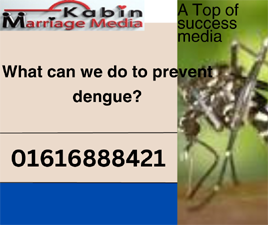What can we do to prevent dengue?
Dengue fever is a mosquito-borne viral disease that poses a significant public health threat in many parts of the world, particularly in tropical and subtropical regions. It is caused by the dengue virus, which is primarily transmitted to humans through the bites of infected female Aedes mosquitoes, particularly Aedes aegypti. Dengue can lead to a wide range of symptoms, from mild flu-like symptoms to severe and potentially life-threatening conditions like dengue hemorrhagic fever and dengue shock syndrome. With no specific antiviral treatment available, prevention is the key to reducing the burden of dengue. In this comprehensive essay, we will explore various strategies and measures that can be implemented to prevent dengue.
- Understanding Dengue
Before delving into prevention strategies, it is essential to understand the virus, its transmission, and the factors that contribute to dengue outbreaks.
- The Dengue Virus: Dengue is caused by four closely related but distinct serotypes of the dengue virus (DENV-1, DENV-2, DENV-3, and DENV-4). Infection with one serotype provides lifelong immunity to that serotype but only temporary protection against the others. Subsequent infections with different serotypes increase the risk of severe dengue.
- Vector Transmission: Aedes mosquitoes, primarily Aedes aegypti and to a lesser extent Aedes albopictus, are the main vectors responsible for transmitting the dengue virus to humans. These mosquitoes are most active during early morning and late afternoon, making those times particularly risky for exposure to mosquito bites.
- Symptoms and Severity: Dengue infections can range from asymptomatic or mild febrile illness to severe forms of the disease. Symptoms typically include high fever, severe headache, joint and muscle pain, rash, bleeding, and easy bruising. Severe dengue can lead to plasma leakage, shock, and death if not treated promptly.
- Dengue Prevention Strategies
To combat dengue effectively, a multi-pronged approach involving individuals, communities, healthcare systems, and governments is necessary. Prevention strategies can be broadly categorized into the following areas:
- Mosquito Control:
- A) Eliminate Breeding Sites: Aedes mosquitoes breed in stagnant water. Reducing or eliminating breeding sites around homes and communities is a critical step. This can include emptying containers, covering water storage containers, and proper disposal of discarded items that can collect rainwater.
- B) Use of Larvicides: In areas with high mosquito populations, larvicides can be used to treat standing water sources, preventing mosquito larvae from developing into adults.
- C) Insecticide Spraying: Indoor residual spraying with insecticides can be used to target adult mosquitoes resting indoors. However, this approach is not as effective against Aedes mosquitoes, which predominantly bite outdoors.
- D) Insecticide-Treated Bed Nets: While primarily used against malaria, insecticide-treated bed nets can also help protect against nighttime mosquito bites, including those from Aedes mosquitoes.
- Personal Protection:
- A) Use of Repellents: Applying mosquito repellents on exposed skin can be effective in preventing mosquito bites. Repellents containing DEET, picaridin, or oil of lemon eucalyptus are recommended.
- B) Wearing Protective Clothing: Wearing long-sleeved shirts, long pants, socks, and shoes can reduce exposed skin and minimize the risk of mosquito bites.
- C) Avoid Peak Mosquito Activity Times: Since Aedes mosquitoes are most active during early morning and late afternoon, it’s advisable to limit outdoor activities during these times or take extra precautions.
- D) Window and Door Screens: Installing screens on windows and doors can prevent mosquitoes from entering homes and buildings.
- Community Engagement:
- A) Education and Awareness: Raising awareness about dengue transmission, symptoms, and prevention measures is crucial. Communities should be informed about the importance of eliminating breeding sites and personal protection.
- B) Community Cleanup Campaigns: Engaging communities in regular cleanup campaigns can help reduce mosquito breeding sites in public spaces and private residences.
- C) Collaboration with Local Authorities: Local governments and health authorities should work together with communities to implement and enforce mosquito control measures effectively.
- Integrated Vector Management:
- A) Source Reduction: Source reduction involves identifying and eliminating breeding sites in an organized and ongoing manner. It is a fundamental component of dengue prevention.
- B) Chemical Control: In areas with high dengue transmission, targeted use of insecticides can be considered, especially during outbreaks. However, this should be done with caution to prevent environmental and health risks.
- C) Biological Control: The use of natural predators like copepods and larvivorous fish in water bodies can help

Dengue is a mosquito-borne viral infection that causes a severe flu-like illness. It is a major public health problem in many tropical and subtropical countries, including Bangladesh. In recent years, dengue outbreaks have become increasingly common and severe, resulting in a devastating impact on many families.
The devastating impact of dengue on families
Dengue can have a devastating impact on families in a number of ways. First, the medical costs of treating dengue can be significant, especially for families who live in poverty. Second, dengue can lead to serious complications, such as severe bleeding and organ failure, which can be fatal. Third, dengue can keep people from working and going to school, which can lead to financial hardship for families.
Case studies of families destroyed by dengue
Here are two case studies of families that have been destroyed by dengue:
Case study 1:
The Rahman family lived in a small village in Bangladesh. They were a poor family, but they were happy and content. One day, the youngest child, a 5-year-old boy named Jamal, contracted dengue. Jamal’s parents took him to the hospital, but the doctors were unable to save him. Jamal died of dengue fever a few days later.
The loss of Jamal was a devastating blow to the Rahman family. Jamal’s parents were heartbroken, and they struggled to cope with his death. Jamal’s father lost his job because he was too grief-stricken to work. Jamal’s mother fell into a deep depression and became unable to care for the family.
The Rahman family’s story is just one example of the devastating impact that dengue can have on families. Dengue can destroy families both emotionally and financially.
Case study 2:
The Begum family lived in a city in Bangladesh. They were a middle-class family, and they had a good life. One day, the father, a 45-year-old man named Mr. Begum, contracted dengue. Mr. Begum was a successful businessman, and his family relied on him for their income.
When Mr. Begum fell ill, he was unable to work. The family’s savings quickly dwindled, and they were forced to sell their belongings to pay for Mr. Begum’s medical bills. Mr. Begum’s condition worsened, and he eventually died of dengue fever.
The death of Mr. Begum was a devastating blow to the Begum family. Mrs. Begum was left to raise two young children on her own. She struggled to find a job, and the family was forced to move into a smaller and less expensive home.
The Begum family’s story is another example of the devastating impact that dengue can have on families. Dengue can rob families of their breadwinners and leave them struggling to survive.
Preventing dengue
There is no cure for dengue, but there are steps that can be taken to prevent it. The best way to prevent dengue is to avoid mosquito bites. This can be done by using mosquito repellent, wearing long sleeves and pants, and sleeping under a mosquito net.
It is also important to eliminate mosquito breeding grounds around the home. This can be done by emptying standing water, clearing away overgrown vegetation, and covering trash cans.
Conclusion
Dengue is a serious public health problem that has a devastating impact on many families. The best way to prevent dengue is to avoid mosquito bites. If you or someone you know contracts dengue, it is important to seek medical attention immediately.
Additional information on the impact of dengue on families
Dengue can have a significant impact on families in a number of other ways, including:
- Social isolation: Dengue can lead to social isolation, as people may be afraid to come into contact with someone who is sick with dengue. This can be especially difficult for children and young people, who may miss out on important social activities and relationships.
- Mental health problems: Dengue can lead to mental health problems, such as anxiety, depression, and post-traumatic stress disorder (PTSD). This can be due to the physical and emotional trauma of the illness, as well as the financial and social hardships that it can cause.
- Long-term health problems: Dengue can lead to long-term health problems, such as chronic fatigue and muscle pain. This can make it difficult for people to work, go to school, and participate in activities that they enjoy.
What can be done to help families affected by dengue?
There are a number of things that can be done to help families affected by dengue. These include:
- Providing financial assistance: Families affected by dengue may need financial assistance to cover the costs of medical treatment and other expenses. This can be provided by governments, non-governmental organizations (NGOs), and individuals
Beware of dengue mosquitoes now
Beware of Dengue Mosquitoes: Protecting Yourself and Your Community
Dengue mosquitoes, primarily Aedes aegypti and Aedes albopictus, pose a significant health threat in many parts of the world. These mosquitoes are vectors for the dengue virus, which can cause a wide range of symptoms, from mild fever and joint pain to severe and potentially life-threatening conditions like dengue hemorrhagic fever and dengue shock syndrome. To protect yourself and your community from these pesky and dangerous insects, it is crucial to be aware of the following:
- Breeding Sites: Dengue mosquitoes breed in stagnant water. Be vigilant in and around your home. Empty containers that collect rainwater, cover water storage containers tightly, and ensure proper disposal of discarded items that can accumulate water. Even small puddles can become breeding sites.
- Personal Protection: Dengue mosquitoes are most active during early morning and late afternoon, making these times particularly risky for mosquito bites. Use mosquito repellents containing DEET, picaridin, or oil of lemon eucalyptus on exposed skin. Wear long-sleeved shirts, long pants, socks, and shoes to minimize exposed skin. Avoid outdoor activities during peak mosquito activity times if possible.
- Screens and Nets: Install screens on windows and doors to prevent mosquitoes from entering your home. Using insecticide-treated bed nets can provide additional protection, especially during sleep when you are vulnerable to mosquito bites.
- Community Engagement: Educate your community about dengue transmission, symptoms, and prevention measures. Encourage participation in regular cleanup campaigns to eliminate mosquito breeding sites in public spaces and private residences. Collaborate with local authorities and health organizations to ensure effective mosquito control measures.
- Integrated Vector Management: Support source reduction efforts in your community. Identify and eliminate breeding sites in an organized and ongoing manner. Be cautious with chemical control measures, using them sparingly and following safety guidelines. Consider biological control methods, such as introducing natural predators to water bodies.
Dengue mosquitoes are relentless in their quest to find breeding sites and bite humans, but with vigilance, awareness, and concerted community efforts, we can reduce the risk of dengue transmission. Remember that dengue prevention is not just an individual responsibility; it’s a collective effort to protect our communities and loved ones from this potentially deadly disease. Stay informed, stay vigilant, and together, we can beat dengue mosquitoes.
sensible match
bangladeshi matrimonial site
patri chai


